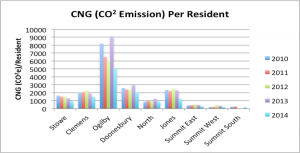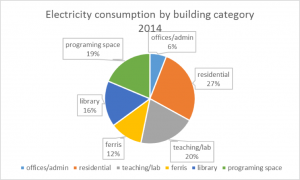Trinity College has a relatively small campus located in downtown Hartford, but it’s also an old campus, which means that much of the core infrastructure is outdated and energy inefficient. Over the years, Trinity has tried to update this infrastructure, but for a number of reasons improvements have tended to be reactionary rather than proactive. To some degree that changed about a decade ago when, like many of its peer liberal arts institutions Trinity began to publicly affirm an increased commitment to sustainability. Notably, in 2007 this took the form of our past president James F. Jones Jr. signing the American College and University Presidents’ Climate Commitment. As a result a campus sustainability task force was formed, and additional commitments made by Trinity and its facilities management contractor to reduce energy consumption. This led to an effort to measure and track energy consumption and greenhouse gas emissions, which also met new Connecticut state reporting regulations. Information on many of these initiatives can be found on the sustainability portion of Trinity’s website.
In 2014 Trinity’s progress on these efforts stalled with the departure of several key staff members who had maintained its’ greenhouse gas emissions and other energy-related reports. So, with the interest of students in our Environmental Science program, we embarked on an effort to update and improve Trinity’s sustainability-related data reporting. What follows are the results of this work, presented as reports produced by two students who worked on slightly different aspects of this project:
 Phase I. Updated Carbon Footprint Analysis for Trinity College, Hartford, CT by Daniel Hong (’15). Daniel wanted to update Trinity’s greenhouse gas emissions reports to fill the gap left by staff departures, which he succeeded in doing. His research and digging also revealed though that there were a lot of holes in Trinity’s energy data, an aspect of the project which a subsequent student worked on. Daniel’s draft report is available here.
Phase I. Updated Carbon Footprint Analysis for Trinity College, Hartford, CT by Daniel Hong (’15). Daniel wanted to update Trinity’s greenhouse gas emissions reports to fill the gap left by staff departures, which he succeeded in doing. His research and digging also revealed though that there were a lot of holes in Trinity’s energy data, an aspect of the project which a subsequent student worked on. Daniel’s draft report is available here.
Phase II. Electricity and Natural Gas Usage at Trinity College, Hartford, CT by Vanja Babunski (’18). Vanja’s work dovetailed with Daniel’s in that she sought to start filling in the data gaps that he had uncovered. She discovered that these apparent gaps were actually features of Trinity’s energy distribution system, which directs much of the college’s electricity through only two meters. There are very few individual buildings on campus with their own meters, which makes building-level evaluations of energy consumption impossible. Vanja built on these early data sleuthing successes by calculating energy consumption estimates for individual buildings.
“Electric companies invest close to a $100 billion each year just to strengthen the electricity grid and develop cleaner generation sources. Energy is a big deal nowadays, and sustainable energy solution can save consumers a lot of money and protect the environment! So, is Trinity College an energy efficient campus? Is it on its way to becoming one? I wanted to see how much electricity each building consumes in order to make power consumption more cost efficient and environmentally friendly. Here is what I found.” Vanja Babunski

